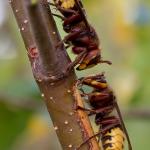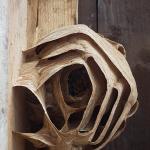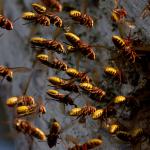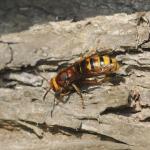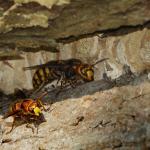Vespa altaica PÉREZ 1910; Vespa anglica GRIBODO 1892, preocc.; Vespa birulai BEQUAERT 1931; Vespa borealis REDOSZKOWSKI 1863; Vespa caspica PÉREZ 1910; Vespa chinensis BIRULA 1925, preocc.; Vespa crabroniformis SMITH 1852; Vespa fasciata CAMERON 1903; Vespa germana CHRIST 1791; Vespa gribodoi BEQUAERT 1931; Vespa major RETZIUS 1783; Vespa meridionalis BIRULA 1925; Vespa oberthuri DU BUYSSON 1902; Vespa pratensis GEOFFROY 1785; Vespa tartarea DU BUYSSON 1905; Vespa vexator HARRIS 1776; Vespa vulgata BIRULA 1925
The 'hornet' occurs in many parts of England and Wales extending from Cornwall to Kent and northwards to Yorkshire. It also occurs on the Isles of Scilly, Isle of Wight and the Channel Islands (Jersey and Guernsey). Hornets are noticeably scarce in Kent and East Sussex, and much less frequent in other parts of south-east England than before 1950. From the 1970s, hornets spread to the north Midlands and Yorkshire: previous records for these localities were at the beginning of the 20th century.
This species is not regarded as being threatened.
Found in many lowland habitats, but particularly associated with ancient deciduous woodland (e.g. New and Sherwood Forests). Also associated with houses and outbuildings in farming areas and sometimes in more urban situations.
Queens emerge from their overwintering sites from early April. The first workers emerge from late June to early July. Males and females mainly emerge during September. Workers may still be seen in October or occasionally early November.
The prey of hornets includes other species of social wasp, honey bees, flies, butterflies, moths (hornets can forage in moonlight) and spiders (Pawlyszyn, 1994). Prey are often taken from flowers and the vegetation of trees. In addition, exudations (flux) are collected from the damaged roots and branches of oak trees (Bunn 1988b; Pawlyszyn 1994). Ash and lilac twigs are ring-barked to encourage sap flow which is then collected (Edwards 1980). The secretions of aphids on goat willow are also taken (Pawlyszyn 1994).
Nests are initiated from the middle of May (Bunn 1988a; Pawlyszyn 1994). They are usually in aerial situations, particularly inside hollow trees, but are also in attics and outhouses. Some nests are constructed at the base of tufts of grass and in cavities in the nests of Lasius flavus; also a few nests are fully underground. A colony may relocate its nest if the initial nesting cavity becomes too small (Pawlyszyn 1992, 1994). The nest is built from pulp collected from decayed wood (Bunn 1988b). The death of the colony is usually in October, or occasionally November (Bunn 1988a). See also Archer (1993).
Records of foraging for nectar are few; ivy has been mentioned (Pawlyszyn 1994).
Hornet nests are well known to contain many species of insects. Amongst these may be mentioned: scavengers, e.g. Fannia canicularis (Diptera) and Ptinus fur (Coleoptera) feeding on decaying organic matter; predators, e.g. Velleius dilatatus and Korynetes caeruleus (Coleoptera) probably feeding on the brood stages; parasitoids, e.g. Sphecophaga vesparum (Hymenoptera) attacking sealed brood. Fungus-feeders eat the moulds and other fungi that grow on damp nest materials. See also Edwards (1980).
1997


